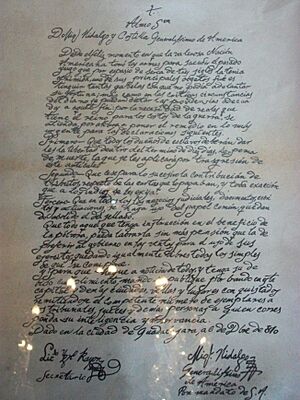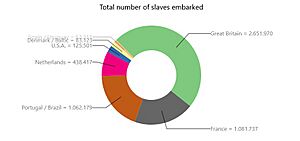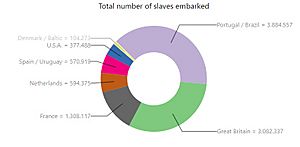Slavery in New Spain facts for kids
Slavery in New Spain was a system where people were treated as property. It mainly involved bringing enslaved people from West and Central Africa to work in the colony. They were forced to labor on large farms, ranches, and in mines. Enslaved Africans were often seen as strong enough to work in hot climates.
The biggest slave traders in what is now Mexico were the Portuguese and the English. The countries that controlled the transatlantic slave market, sending the most enslaved people, were the United Kingdom, Portugal, and France.

In 1517, King Charles V allowed his subjects in the Americas to use enslaved people. This started the slave trade in the region. When the Spanish arrived in New Spain, they brought some enslaved African workers with them.
Some religious leaders, like the Dominican friars, spoke out against the harsh treatment of Native Americans. They told the Spanish king that this treatment was unfair and against the law.
In 1639, Pope Urban VIII issued a special order called a bull. This order banned slavery in the Spanish and Portuguese colonies in America. King Philip IV of Spain agreed to ban the enslavement of Native Americans. However, he still allowed the enslavement of people from Africa.
Many enslaved people found freedom by escaping. They hid in the mountains of Orizaba, Xalapa, and Córdoba in Veracruz. These escaped individuals were known as Cimarrones, or maroons.
African Slavery in New Spain
People from Africa became a very important part of society in Mexico, alongside Native Americans and Spaniards. During this time, people were bought and sold as part of international trade. Europeans captured people in Africa and shipped them to the Americas. Most Africans arrived in New Spain as enslaved people, forced to do very hard work.
Many Native Americans died from new diseases, wars, and social problems. Because of this, Europeans brought millions of people from Africa to work as enslaved laborers. Many enslaved Africans died during the long journey across the ocean, known as the Middle Passage. Others died in the Americas due to terrible working conditions, especially in the Caribbean and South America.
Enslaved people from Africa were seen as a way to get enough workers for the new lands. The Mexican government recorded that about 36,500 enslaved Africans arrived between 1521 and 1594. Then, from 1595 to 1622, 322 ships brought another 50,525 enslaved people to Mexican ports. By 1810, there were about 625,000 free people of African descent and 10,000 enslaved people in Mexico. They worked on sugar cane farms and in many other jobs. Slave owners made a lot of money from their labor.
Both men and women were enslaved. Men often worked in the fields or in physical trades. Women sometimes worked in the fields too. But they also worked in homes as nurses, washerwomen, cooks, maids, or seamstresses.
Enslaved people sometimes complained to the Holy Office (a religious court) hoping to get help. Since there were no good civil courts to report mistreatment, some Afro-Mexicans saw the Inquisition as a way to improve their terrible situation.
Enslaved Africans in New Spain had two ways to seek legal protection:
- The first was through surprise visits to workplaces. Officials would check for abuses against workers, including enslaved people.
- The second was when witnesses or the enslaved people themselves reported their owner for mistreatment to the Holy Office. However, getting protection this way was very rare during the colonial period.
Native American Slavery
The Spanish conquest led to the first cases of slavery in New Spain. Spanish soldiers asked the king for permission to bring enslaved people from Spain to help them. They knew they would have to work hard to conquer the land. They also knew some Native American leaders would fight back and not become Catholic. The Spanish leader, Hernán Cortés, asked to take and distribute enslaved people "as is customary in the land of infidels, for it is a very just thing."
Spanish settlers took Native Americans as enslaved people in New Spain, just like they did in the West Indies. They enslaved those who lost wars. Sometimes, they took control of people who were already enslaved by other Native American tribes. In the first case, the Spanish enslaved people who had been free. In the second, they changed traditional Native American slavery to a system with some European laws.
Enslaved people could be traded under Spanish rule. To show who owned them, enslaved people were sometimes marked on their face or body. Legally, their situation was worse than that of free Native Americans.
On May 14, 1524, a "royal iron" arrived in New Spain. The King of Spain sent it to mark Native American enslaved people on their leg, buttock, arm, or face. This was called the "ransom iron." Later, the buying or inheriting of enslaved Native Americans was successfully stopped. However, it was still allowed for those captured in war. This mainly included Native Americans in the northern part of the country who fought against Spanish rule.
The New Laws of 1542 changed conditions for Native Americans. These laws said that Native Americans were physically weaker than Africans. So, efforts were made to protect them. These laws strictly banned slavery in the future. They also ordered a review of existing cases of servitude. Enslaving Native Americans captured in war was forbidden. However, the laws still allowed for Native Americans who were hostile to the colonists to be captured in some cases.
Despite these laws, the exploitation of Native Americans continued. Many Native Americans died from new diseases brought by Europeans and Africans. This caused a huge drop in the Native American population. To keep production going, Viceroy Enríquez suggested buying enslaved Black people for the king in 1580. These enslaved people would then be sold at cost to miners, sugar cane farmers, and other Spanish business owners. From then on, more enslaved Africans were legally brought into New Spain, with permission for five thousand a year.
End of Slavery
Enslaved people could sometimes buy their freedom. They might get a loan or be freed by their owners before they died. In other cases, enslaved people escaped and hid in jungles and mountains. As more people escaped, small communities formed. These were known as Palenques. Freed enslaved people who feared being re-enslaved would come to these places.
Ending slavery was a key goal for those fighting in the Mexican independence war. Miguel Hidalgo y Costilla ordered that slavery be abolished. This order was published in different places by various leaders in late 1810. Hidalgo himself published a decree against slavery in Guadalajara on December 6, 1810.
After Hidalgo died, other leaders continued the fight. Ignacio López Rayón confirmed the abolition of slavery in 1812. José María Morelos did the same in his Sentiments of the Nation in 1813. Once Mexico became independent, presidents Guadalupe Victoria and Vicente Guerrero officially ended slavery with presidential decrees in 1825 and 1829.
See also
- Afro-Mexicans
- Slavery in Brazil
- Slavery in Colombia
- Slavery in the United States
- New Laws
- Gaspar Yanga
 In Spanish: Esclavitud en la Nueva España para niños
In Spanish: Esclavitud en la Nueva España para niños




